全文HTML
--> --> -->为兼顾离轴结构和同轴结构的优势, 2015年, Orzó[27]提出一种同-离轴混合数字全息恢复方法, 先将离轴数字全息恢复的物光复振幅的低频成分提取出来, 再在同轴数字全息迭代的过程中进行低频替换, 实现待测物体的重建, 但当遇到强相位波动的物体时, 其迭代过程无法收敛. 2018年, 王凤鹏等[28]也提出了一种同-离轴混合的相位恢复方法, 利用约束最优化算法[29]从离轴数字全息图中获取物光场的近似相位分布, 并复合同轴全息图的振幅信息作为迭代过程的初始值, 进而利用迭代算法实现待测物体高分辨率重建, 但该方法因为采用平均值滤波, 依然损失了高频成分, 且需多次迭代才能达到效果, 损失了大量的时间; 同时, 其重建过程还需参考光的先验信息, 而在实验过程中很难获取准确稳定的参考光. 尤为重要的是, 以上两种方法都是在物面和全息面之间迭代完成重建工作, 从而需要精准的衍射距离; 衍射距离精准预测需利用聚焦算法, 而其成功是以大量时间消耗为代价的, 这将进一步提高重建难度, 浪费时间成本.
远心成像系统[30-32]是传统数字全息经常采用的一种典型的光路结构, 它可以很好地抑制球面像差和散焦像差的影响, 使同轴数字全息保持最大空间带宽积; 同时, 可根据所需视场的空间分辨率调整缩放系数, 并可根据透镜焦距调整物体和图像传感器的位置, 获得聚焦的清晰图像, 从而在后期图像处理过程中无需对物光复振幅从全息面到物面进行反衍射的数值重建, 进一步避免了衍射距离预测的复杂过程, 节省了时间, 降低了重建难度. 因此, 本文将远心成像技术引入同-离轴混合数字全息技术中, 提出一种远心同-离轴混合数字全息高分辨率重建方法, 充分利用远心成像技术与同-离轴混合技术的优势, 在摈除衍射距离等先验信息以提升重建效率的同时, 抑制干扰项及系统像差, 实现高分辨率系统成像重建.
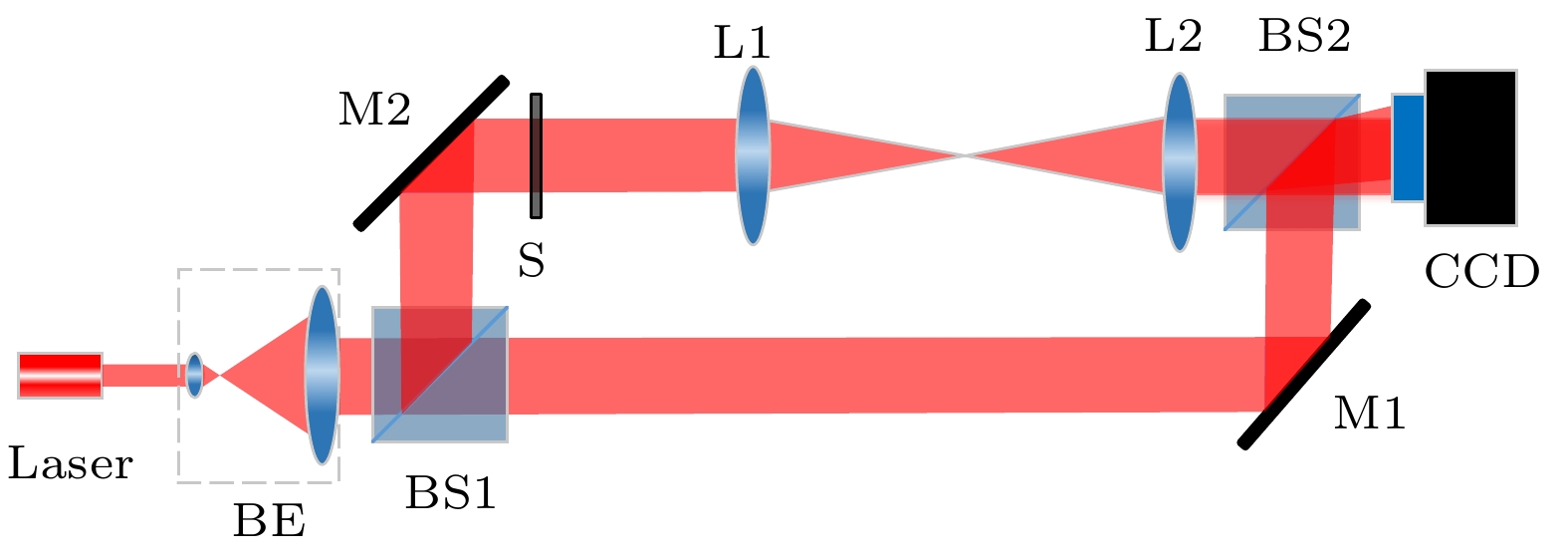 图 1 远心同-离轴混合数字全息成像系统示意图
图 1 远心同-离轴混合数字全息成像系统示意图Figure1. Schematic of the telecentric in-line-and-off-axis hybrid digital holography system.
为了实现上述系统的成像重建, 提出了一种远心同-离轴混合数字全息高分辨率重建方法, 将离轴全息图获得的低分辨率相位信息与同轴全息图的振幅信息相结合作为迭代恢复过程的初始物光复振幅, 并将其在空域和频域的振幅信息作为迭代过程的振幅约束项, 同时将从离轴全息图中获取的物光复振幅低频信息作为迭代过程的频谱约束项, 最终实现物体的高分辨率重建. 重建过程如图2所示, 具体方法如下.
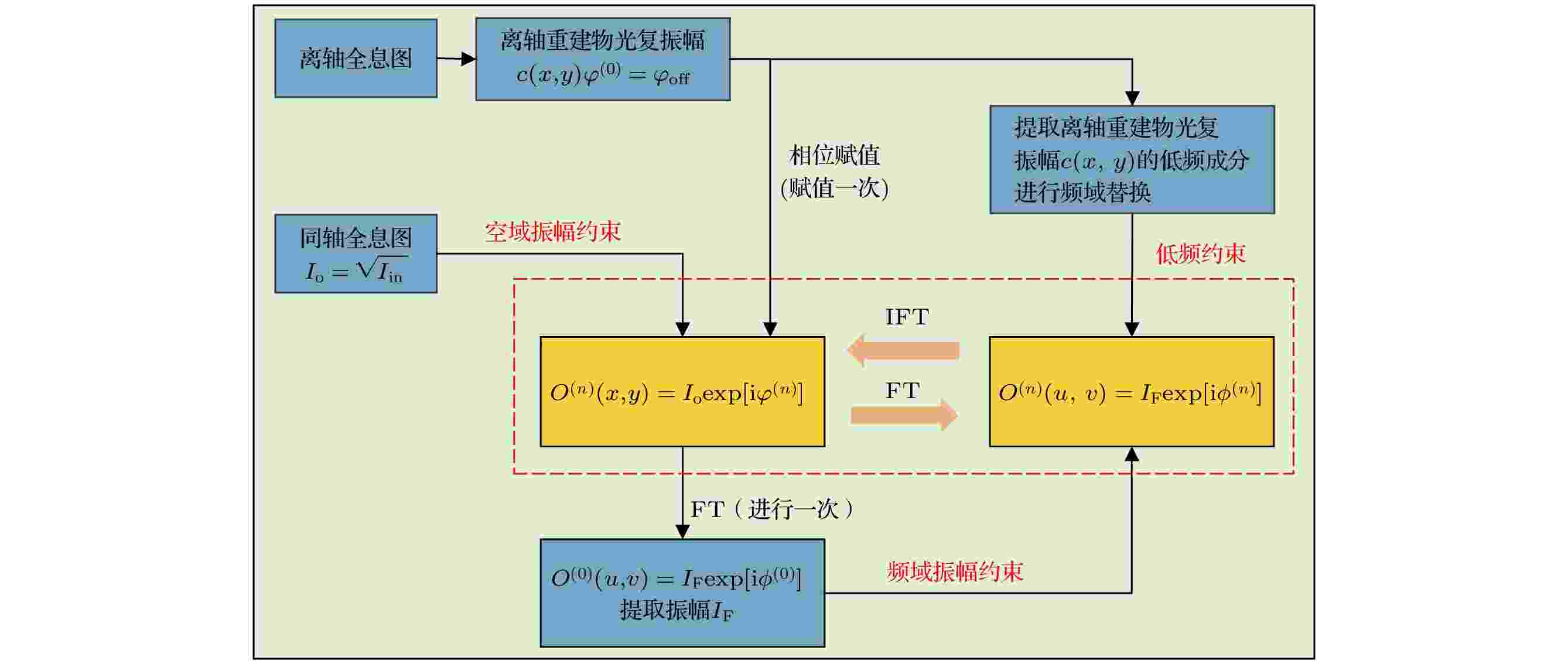 图 2 远心同-离轴混合数字全息重建算法框图
图 2 远心同-离轴混合数字全息重建算法框图Figure2. Schematic of telecentric in-line-and-off-axis hybrid digital holographic reconstruction algorithm.
1)全息图
假设物面的物光复振幅为O(x, y), 则可得到同轴全息图如下:


2)离轴物光场重建
分别对离轴全息图和离轴背景全息图进行傅里叶变换(FT), 可在频谱域中将零频分量和互相关项完全分离; 利用带通滤波器(BPF)选择实像项, 然后再分别进行傅里叶逆变换(IFT), 获取所需的有样品实像物光信息Ooff (x, y)和背景实像物光信息 Ooff_B (x, y), 即
3)同-离轴混合成像重建
(a) 利用同轴全息图的强度

(b)将初始物光复振幅进行傅里叶变换得到频域的复振幅分布为O(0)(u, v) = IF exp [i?(0)], 提取振幅IF, 其中, ?(0)为频域初始物光相位分布;
(c) O(n)(x, y)为第n次迭代所生成的空域物光复振幅, 当n = 0时即为初始物光复振幅. 将空域物光复振幅分布O(n)(x, y) = Io exp[iφ(n)]进行傅里叶变换获得频域物光复振幅, 用第2)步中Olow_off(u, v)替换它的低频成分, 并且用IF替换它的振幅, 得到新的频域物光复振幅O(n)(u, v) = IF exp [i?(n)], 其中, φ(n)和?(n) 分别为空域和频域第n次迭代的相位分布;
(d)将更新后的频域物光复振幅通过傅里叶逆变换获得新的空域物光复振幅, 并用Io替换它的振幅获得O(n+1)(x, y)=Io exp [iφ(n+1)];
(e)重复步骤(c)和(d)进行迭代, 直至收敛. 输出空域物光复振幅分布, 即可得到高分辨率再现象.
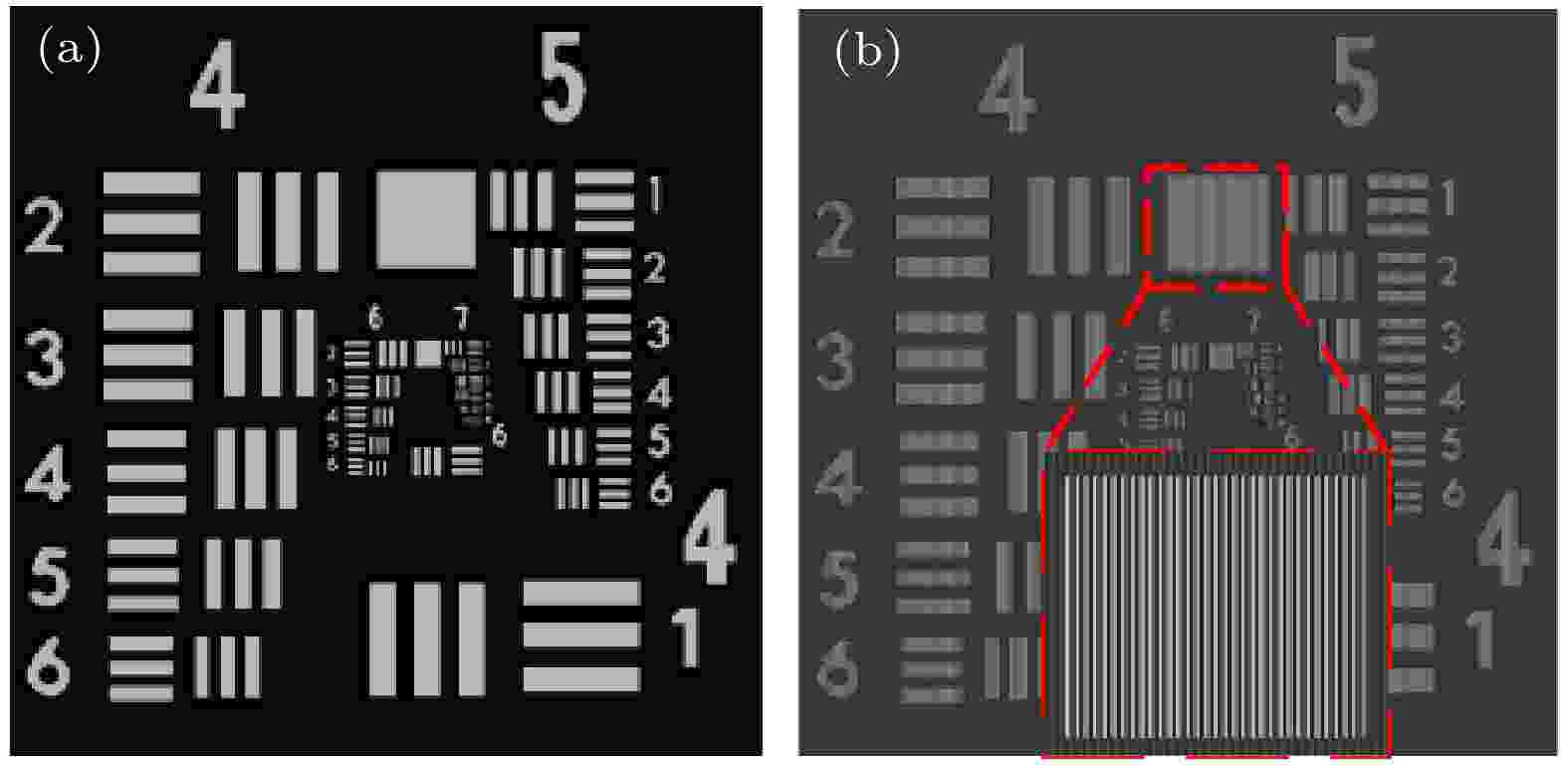 图 3 (a)同轴全息图; (b)离轴全息图
图 3 (a)同轴全息图; (b)离轴全息图Figure3. (a) In-line hologram; (b) off-axis hologram.
利用传统同轴算法[21]对同轴全息图进行重建, 结果如图4所示. 由于重建的是无衍射过程的全息图, 振幅像不受共轭像的影响, 所以保持同轴的高分辨率特性; 但是从相位像看出, 相位值恢复并不准确, 即传统同轴算法不具有准确恢复相位信息的能力.
 图 4 同轴全息图再现结果 (a)振幅像; (b)相位像
图 4 同轴全息图再现结果 (a)振幅像; (b)相位像Figure4. Reconstructed results of in-line hologram: (a) Amplitude image; (b) phase image.
利用离轴频域滤波方法[16]对离轴全息图进行重建, 结果如图5所示. 从振幅像和相位像可以看出, 信息恢复基本准确, 但是由于引入了带通滤波器, 损失了高频信息, 再现像局部放大不清晰, 数字线条轮廓模糊, 分辨率较低.
 图 5 离轴全息图再现结果 (a)振幅像; (b)相位像
图 5 离轴全息图再现结果 (a)振幅像; (b)相位像Figure5. Reconstructed results of off-axis hologram: (a) Amplitude image; (b) phase image.
利用本文的远心同-离轴混合数字全息重建方法对全息图进行重建. 本文采用均方误差 (MSE)对算法的收敛性进行评价, 即



 图 6 再现像误差随迭代次数变化 (a)振幅均方误差收敛曲线; (b)相位均方误差收敛曲线
图 6 再现像误差随迭代次数变化 (a)振幅均方误差收敛曲线; (b)相位均方误差收敛曲线Figure6. Mean squared errors at each iteration: (a) Amplitude mean square error convergence curve; (b) phase mean square error convergence curve.
 图 7 同-离轴混合数字全息再现结果 (a)振幅像; (b)相位像
图 7 同-离轴混合数字全息再现结果 (a)振幅像; (b)相位像Figure7. Reconstructed results obtained by the in-line-and-off-axis hybrid digital holography: (a) Amplitude image; (b) phase image.
| 同轴算法 | 离轴算法 | 混合算法 | |
| 振幅PSNR/dB | 71.55 | 66.54 | 82.37 |
| 相位PSNR/dB | 43.69 | 55.29 | 57.70 |
表1不同算法重建振幅和相位的峰值信噪比
Table1.Peak signal-to-noise ratio (PSNR) of amplitudes and phases reconstructed by different algorithms.
首先, 以USAF分辨率板为待测物体进行验证, 由于该分辨率板是振幅形物体, 因此只给出振幅的重建结果. 图8(a)为同轴全息图, 图8(b)为离轴全息图, 图8(c)为传统同轴算法重建得到的振幅结果, 由于利用远心系统所拍摄的同轴全息图即为非衍射过程的强度图, 因此传统同轴方法重建的振幅结果取决于同轴全息图的强度, 可以观测到第5组第 6个元素, 线宽为8.7 μm, 但是在数字线条附近会出现模糊的虚影. 图8(d)为利用离轴频谱滤波算法对离轴全息图进行重建获得的振幅结果, 明显可见, 放大部分数字线条边界模糊, 细节部分也无法分辨, 能够分辨的第4组第1个元素, 线宽为31.3 μm, 远低于理论分辨率, 究其原因, 是因为离轴全息重建过程采用频域滤波而使高频信息丢失. 图8(e)为混合算法重建获得的振幅结果, 可看出, 放大部分数字线条的边界更加锐利, 中间细节部分更加清晰, 例如第5组中数字旁的伪影也消失不见, 从而说明本方法重建质量既远高于离轴算法, 也优于同轴算法, 且更加接近理论分辨率.
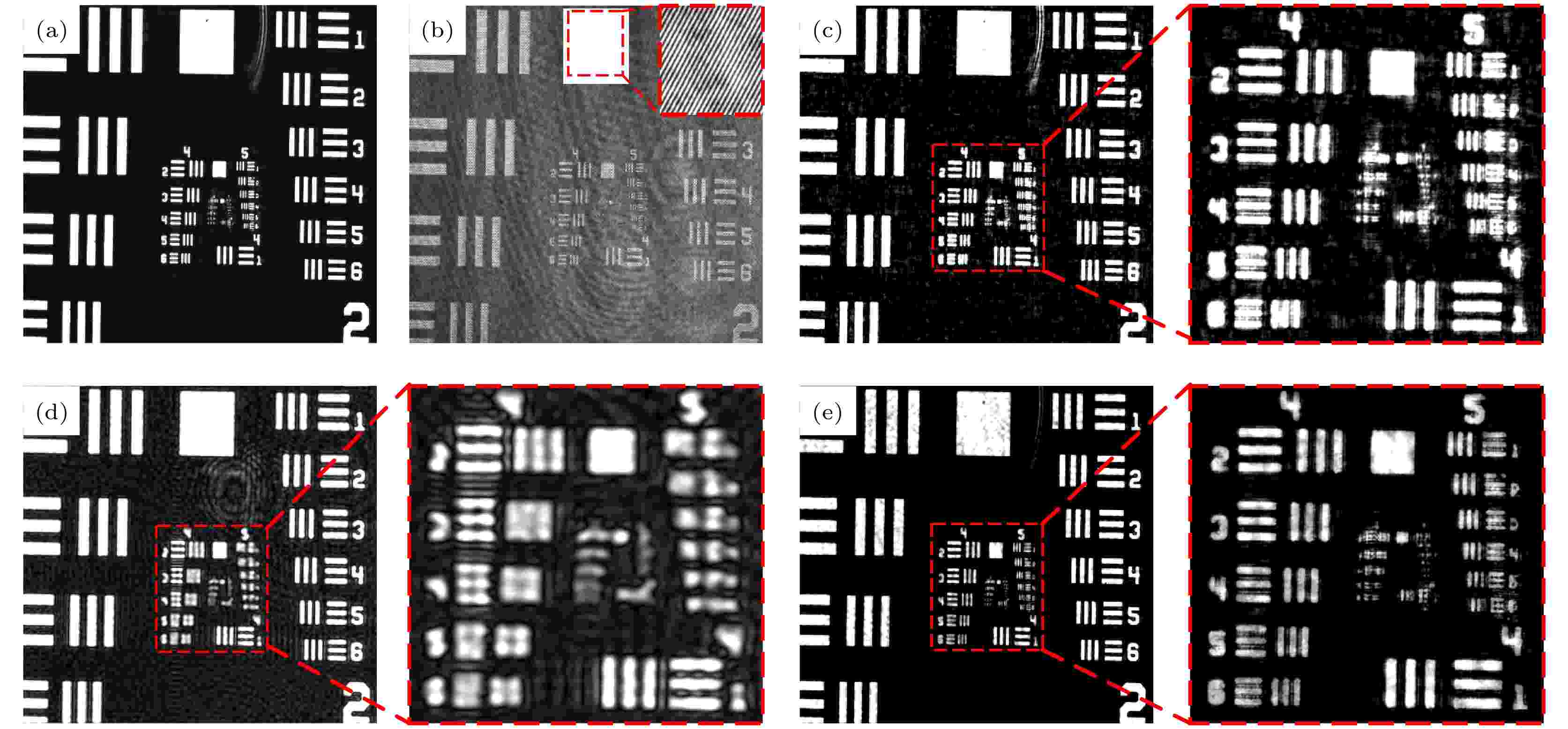 图 8 USAF分辨率板实验结果 (a)同轴全息图; (b)离轴全息图; (c) 同轴数字全息再现像; (d)离轴数字全息再现像; (e)同-离轴混合数字全息再现像
图 8 USAF分辨率板实验结果 (a)同轴全息图; (b)离轴全息图; (c) 同轴数字全息再现像; (d)离轴数字全息再现像; (e)同-离轴混合数字全息再现像Figure8. Experimental results of USAF resolution target: (a) In-line hologram; (b) off-axis hologram; (c) amplitude reconstructed image of the in-line hologram; (d) amplitude reconstructed image of the off-axis hologram; (e) amplitude reconstructed image of the in-line-and-off-axis hybrid digital holography.
在第2个实验中, 以洋葱表皮细胞为待测物体进行实验验证, 获得的同轴全息图如图9(a)所示, 离轴全息图如图9(b)所示, 图9(c)和图9(d)为利用传统同轴算法进行重建所得到的振幅像和相位像. 从振幅恢复结果可以看出, 借助于远心系统的优势, 振幅恢复效果较好地与理论分析保持一致; 但从相位恢复结果看, 没有准确得到洋葱表皮细胞的相位信息分布, 说明传统同轴算法对于远心系统下的聚焦全息图的相位重建能力有限. 图9(e)和图9(f)为利用离轴算法重建得到的振幅像和相位像, 从重建结果可以看出, 洋葱表皮细胞虽然结构清晰可见, 但是高频信息丢失, 分辨率较低. 图9(g)和图9(h)为本文混合算法重建得到的振幅像和相位像. 从振幅恢复结果可以看出, 混合算法可以获得与同轴算法一致的分辨率, 但洋葱表皮细胞纹路边界更加清晰; 从相位像可以看出, 混合算法可以有效恢复出洋葱表皮细胞的相位信息, 且相对于离轴算法提高了细胞纹路的清晰度. 为了更好地比较, 对图9(f)和图9(h)中虚线部分进行剖面, 获得的结果如图9(i)所示, 进一步可以看出, 在细胞壁纹路处, 混合数字全息恢复结果保留了更多的高频信息, 分辨率更高.
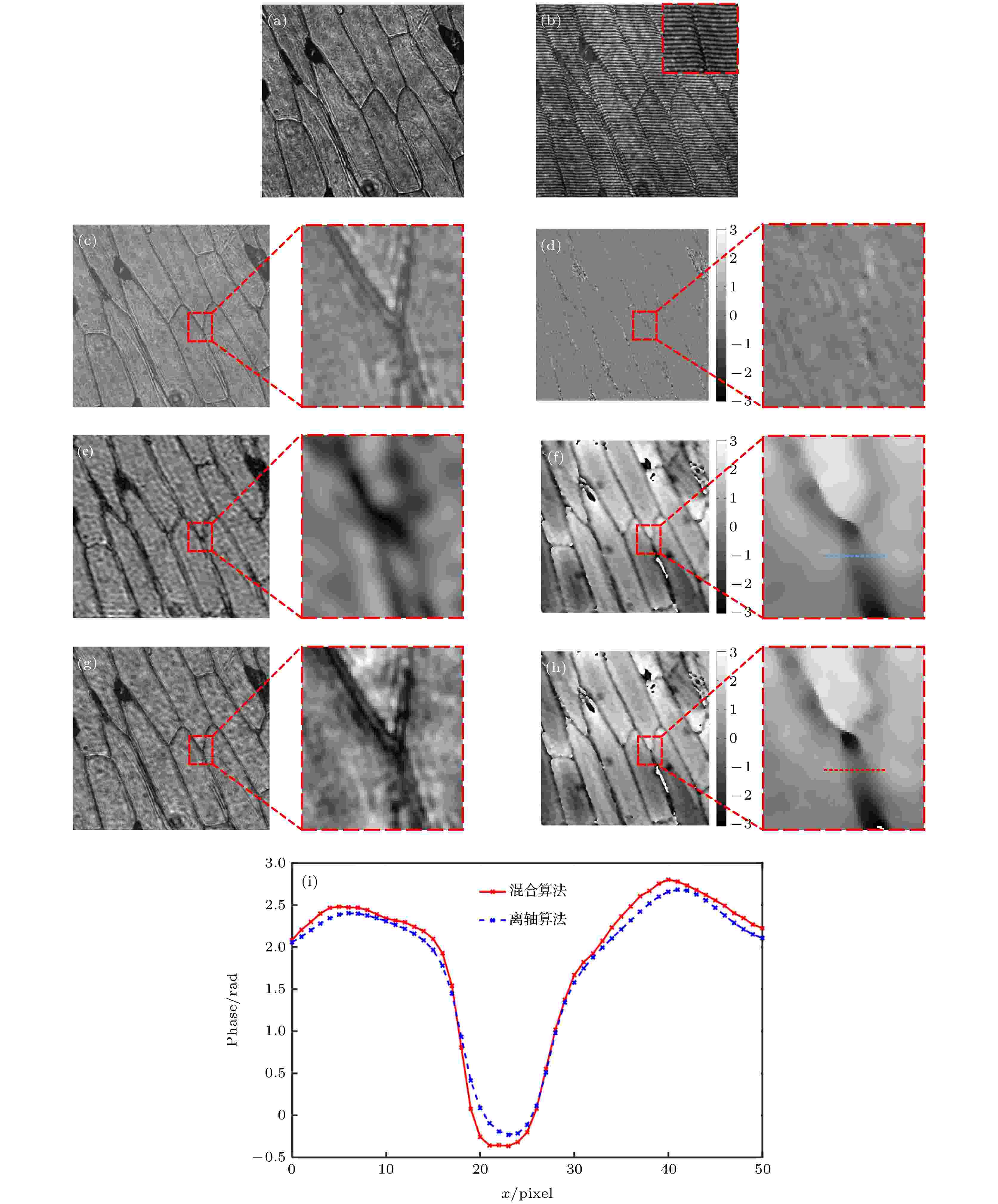 图 9 洋葱表皮细胞实验结果 (a)同轴全息图; (b)离轴全息图; (c)同轴数字全息再现强度像; (d)同轴数字全息再现相位像; (e) 离轴数字全息再现强度像; (f) 离轴数字全息再现相位像; (g) 混合数字全息再现强度像; (h) 混合数字全息再现相位像; (i)相位剖面曲线
图 9 洋葱表皮细胞实验结果 (a)同轴全息图; (b)离轴全息图; (c)同轴数字全息再现强度像; (d)同轴数字全息再现相位像; (e) 离轴数字全息再现强度像; (f) 离轴数字全息再现相位像; (g) 混合数字全息再现强度像; (h) 混合数字全息再现相位像; (i)相位剖面曲线Figure9. Experimental results of onion epidermal cell: (a) In-line hologram; (b) off-axis hologram; (c) amplitude reconstructed image of the in-line hologram; (d) phase reconstructed image of the in-line hologram; (e) amplitude reconstructed image of the off-axis hologram; (f) phase reconstructed image of the off-axis hologram; (g) amplitude reconstructed image of the in-line-and-off-axis hybrid digital holography; (h) phase reconstructed image of the in-line-and-off-axis hybrid digital holography; (i) phase profile curves.
最后, 以蜜蜂翅膀为待测物体进行了实验验证. 图10(a)为蜜蜂翅膀的同轴全息图, 图10(b)为蜜蜂翅膀的离轴全息图. 图10(c)和图10(d)为利用传统同轴算法进行重建得到的振幅像和相位像, 图10(e)和图10(f)为利用离轴算法重建得到的振幅像和相位像, 图10(g)和图10(h)为本文混合算法重建得到的振幅像和相位像, 图10(i)为相位像中竖线部分蜜蜂翅膀纹路的相位刨面图. 从图10可以得到同样的结论, 即混合算法能同时实现振幅图像和相位图像的高分辨率重建, 尤其从图10(i)可以看出, 混合算法可以明显恢复出离轴算法丢失的高频信息, 明显提高了成像分辨率.
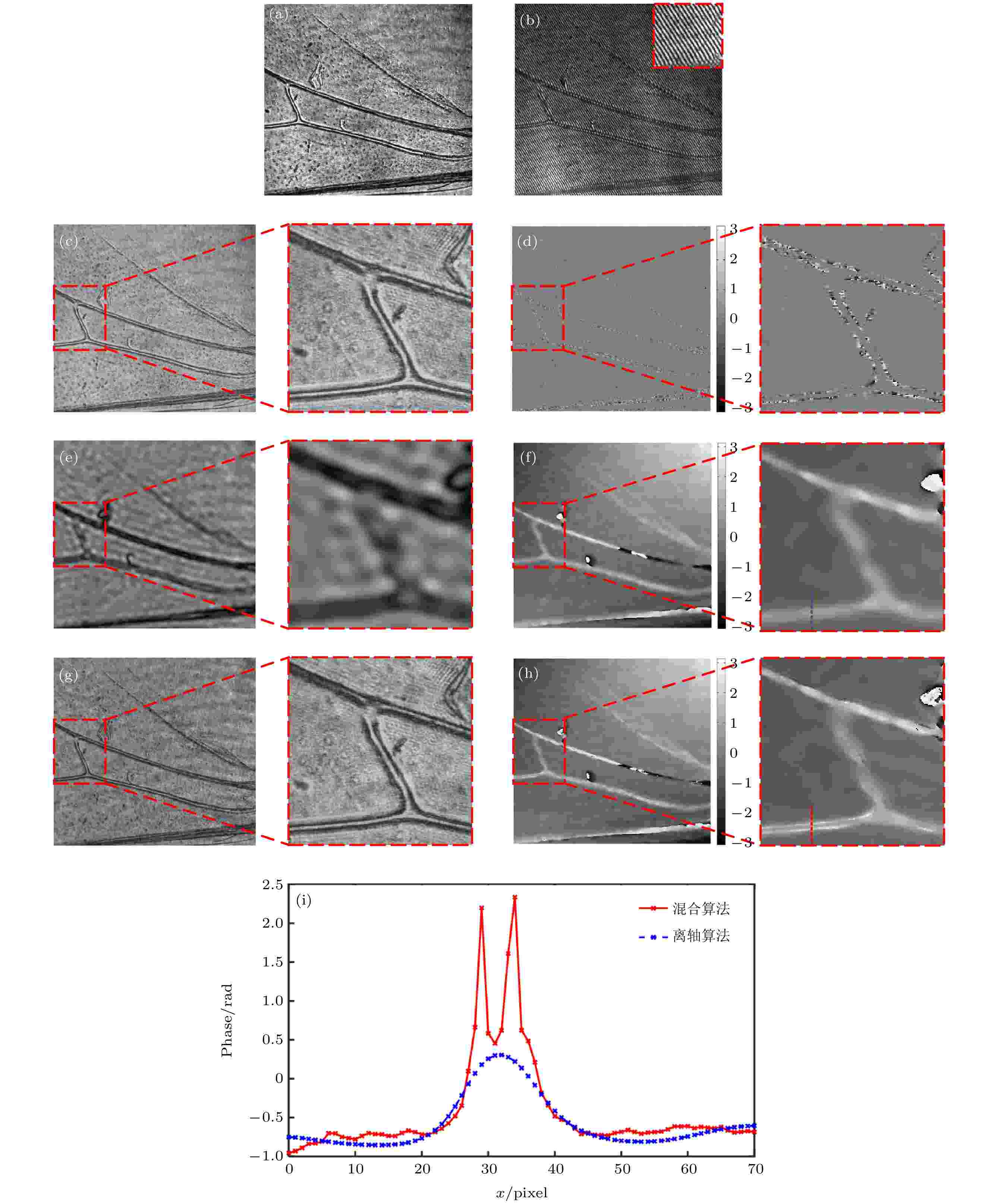 图 10 蜜蜂翅膀实验结果 (a)同轴全息图; (b)离轴全息图; (c)同轴数字全息再现强度像; (d)同轴数字全息再现相位像; (e) 离轴数字全息再现强度像; (f) 离轴数字全息再现相位像; (g) 混合数字全息再现强度像; (h) 混合数字全息再现相位像; (i)相位剖面曲线
图 10 蜜蜂翅膀实验结果 (a)同轴全息图; (b)离轴全息图; (c)同轴数字全息再现强度像; (d)同轴数字全息再现相位像; (e) 离轴数字全息再现强度像; (f) 离轴数字全息再现相位像; (g) 混合数字全息再现强度像; (h) 混合数字全息再现相位像; (i)相位剖面曲线Figure10. Experimental results of bee wings: (a) In-line hologram; (b) off-axis hologram; (c) amplitude reconstructed image of the in-line hologram; (d) phase reconstructed image of the in-line hologram; (e) amplitude reconstructed image of the off-axis hologram; (f) phase reconstructed image of the off-axis hologram; (g) amplitude reconstructed image of the in-line-and-off-axis hybrid digital holography; (h) phase reconstructed image of the in-line-and-off-axis hybrid digital holography; (i) phase profile curves
